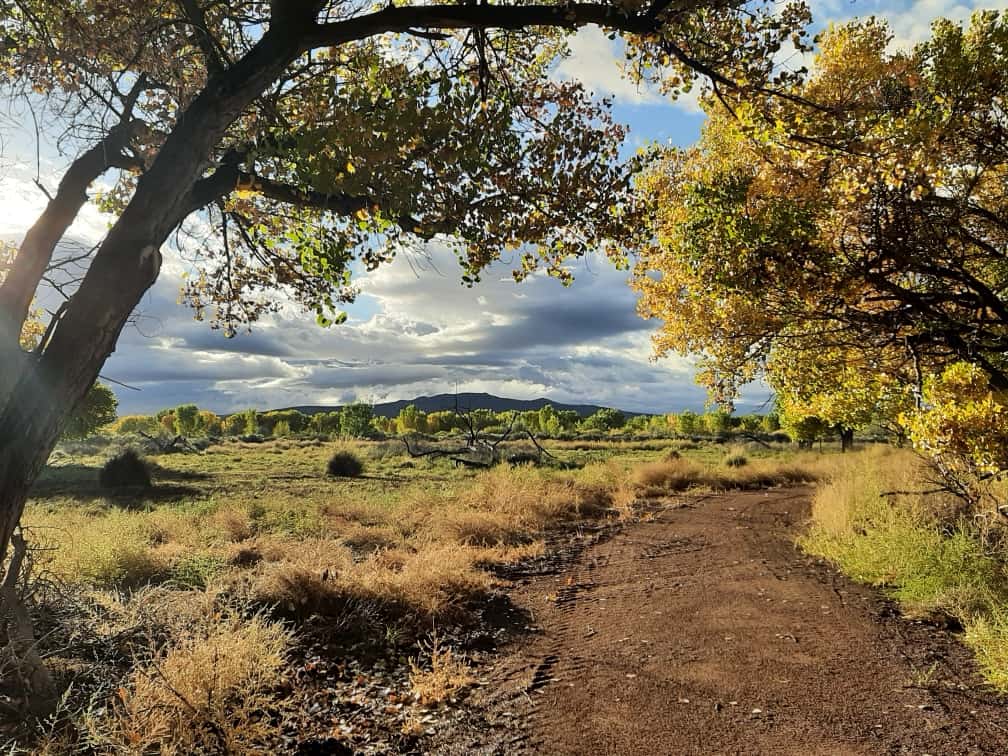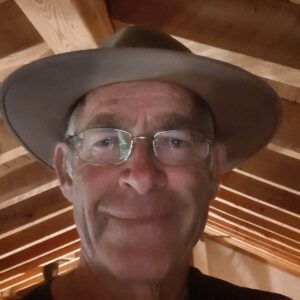New Mexicans have something very special in our lives – we live in New Mexico, The Land of Enchantment. It is a landscape of so many hidden treasures, a land of oohs and awes. One of my favorite places to indulge my love of the natural world is the Bosque del Apache National Wildlife Refuge. The Refuge covers 57,331 acres and over 30,000 acres are set aside as 3 wilderness areas: the Chupadera, the Little San Pascual and Indian Well.
Most visitors come during the winter months to see the cranes, whose numbers have been growing each year. It is quite difficult to imagine the cacophony of deafening sound, 10,000 Sandhill Cranes and 50,000 Snow Geese fill the air with, unless, you have stood nearby in stunned wonder.
A few years back I was preparing to give a presentation as Aldo Leopold at the 31st Festival of the Cranes. I was parked at the edge of a field just at sunrise. To my utmost delight, over 200 cranes were arriving in full chorus to strut about the field. With those immense wings held out and spindly legs bouncing and dancing, I was spellbound in awe. It was an experience to drown out all others. There is no faster way to transport ones’ self to an elevated stage of joy than to be audience to a morning Crane choir.
In 1939, Aldo Leopold wrote a piece he titled, “The Marshland Elegy”. When he wrote the Elegy, he thought the Sandhill Cranes were not going to be around in Wisconsin much longer as their habitat was greatly diminished and their numbers very low. A friend of his, Owen Gromme, taxidermist and artist at the Milwaukee Public Museum, after reading the Marshland Elegy, wrote to him. Gromme said, “Only a man who has worked with these noble birds can possibly grasp the full import and depth of your written words. There is no sound on this earth that stirs the primitive in me like the indescribable wild rattle of the Sandhill Crane. Well, I guess that you understand. You said it all.”
Once you have heard the wild rattle of the Sandhill Cranes, you will always know the call. A few weeks ago, I was out in our yard in Kingston, when I heard them and my eyes quickly went into search mode, scanning the skies. They fly 1000 feet or higher and so are often heard but not seen. This time though, there they were. About 100 cranes in a huge V heading towards the Wilcox Playas in southern Arizona.
A week ago, at the Refuge, when the dawn was touching the changing leaves with an almost ethereal light, I met with Deb Caldwell. She is the Executive Director of the Friends of the Bosque. As we walked the trails in the early morning light, we saw signs of a very diverse population of wildlife. The trails had been quite popular that morning, littered with elk sign and crane tracks. We laughed about being careful walking near the “Crane Tracks.” I learned that the Rio Grande Bosque is the largest ecosystem of its kind in the world. It begins at Cochiti Lake and continues south for 200 miles to end where we were walking, the Bosque del Apache National Wildlife Refuge.
The tree of such outstanding colors which is the backbone of the bosque, is Populus deltoides wislizenii, the Rio Grande Cottonwood. A fact of great concern is that they only live for 80 -100 years and most of the bosque cottonwoods are already 75 years old. Mainly because of the flood control measures implemented on the river, the periodic flooding the trees need to produce seedlings, has not happened in their lifetime. A harsh reality is that the cottonwood bosque as we know it now in all of its splendor, may not be around much longer. There are dedicated groups currently working to change this, but it is a monumental task.
As Deb and I enjoyed our early morning stroll, we spoke about the diversity of life found on the Refuge. People mainly come for the Sandhill Cranes, but those statuesque birds are just residents for a few months. When the refuge was established in 1939 to act as a critical stopover site for migrating waterfowl, the first bird count only totaled 17 Sandhill Cranes. In 83 years of providing habitat for the migrating cranes, that number has grown to over 10,000 for the migration, a success story in times of many wildlife crises.
There have been 374 different bird species identified at the Refuge. That makes it one of the most diverse birding areas in the United States. Also seen on the refuge are elk, mule deer, mountain lion, bobcat, fox, racoons, skunks, coyotes and the rest of the mammal entourage that call the Refuge home. Roadrunners, bald eagles, hummingbirds flitting from wildflower to wildflower and butterflies in abundance also add their stories to this diverse landscape of habitat. So, no matter what time of year you amble the Refuge grounds, there are always fascinating stories to be seen, heard and read.
As I am always prodding people to get out and absorb some healing nature time, I want to say that a great way to spend a day or two is to attend this years’ FESTIVAL OF THE CRANES AT the Bosque del Apache National Wildlife Refuge from Thursday, December 1 through Saturday, December 3. You can find out more from the festival website or call Friends of the Bosque del Apache at (575) 838-2120 or Festival of the Cranes at (575) 835-2077.
A visit to the Refuge anytime of year is a most rewarding experience, but there is a very special aire abounding when the Sandhill Cranes and Geese are in residence. Take a walk. Be it in the wilds of your backyard or along the Rio Grande. Enjoy.

